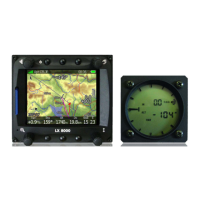LX8000 version 0.96 April 2008
Page 80 of 85
The angular difference between HDG and TRK depends on the magnitude of the wind vector
and is normally quite small which means that the measurement has to be quite precise if
accuracy is to be achieved. While the GPS data (TRK and GS) is precise, small inaccuracies in
the heading of about 5° can cause errors of up to 25 km/h in the wind strength. This
method only works during straight flight and the calculation is stopped as soon as HDG and
TAS change rapidly as occurs when the glider is turning.
9.2.2 Installation of the compass module
The device consists of two parts, a compass sensor and electronic device. The compass
sensor should be built somewhere far from iron parts, which can cause errors in reading.
Respect flight direction arrow and install the unit horizontally. All connections are plug and
play, so no mistake possible is possible. A 485 splitting unit to extend RS485 bus is included.
The box with electronics could be installed on the convenient place in the glider, orientation
doesn’t matter.
The orientation is clearly marked on the label which is on the bottom of the unit.
9.2.2.1 Where to install
The compass module should be installed as far as possible away from magnetic, electrical
and steel parts (loud speakers and analogue vario indicators contain strong magnets). Even
the mechanical compass should be as far away from the sensor as possible. Minimum
distance is 20cm. As mentioned above, the arrows should be aligned accurately in the flight
direction and parallel to the fore and aft axis of the glider. For a proper installation a flat
area parallel to the horizontal plane is needed.
9.2.3 First test after installation
An external reference compass is required which can either be a prismatic landing compass
or a calibrated compass base on the airfield surface. Using the reference compass, the glider
should be aligned in each of the eight main directions (360°, 45°, 90°, 135°, 180°, 225°,
270°and 335°). Now the glider should be oriented into north direction, while doing that
watch the HDG raw data on compass calibration page (do not try to compensate the
compass yet!). If the HDG varies more than ±5°, rotate the compass so, that the deviation
decreases below ±5°.
Now turn the aircraft into the other directions and read the displayed values (don’t change
the compass position anymore). If they vary more than ±15° look for another place for the
compass module.
Wind
True airspeed
and true
heading
Ground speed and
ground track

